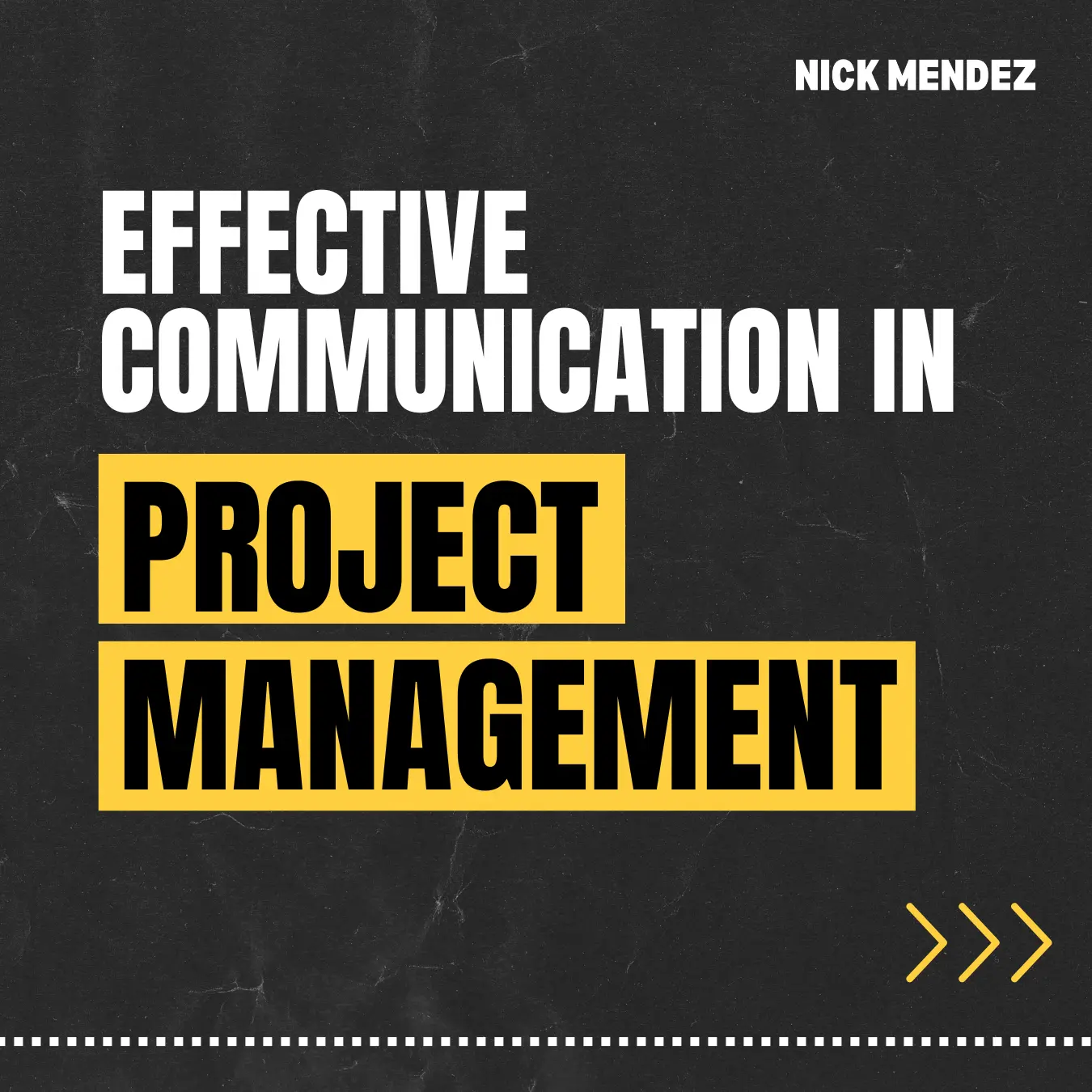Effective Communication in Project Management
Table of Contents

About the Author – About Nicholas Mendez (Nick Mendez):
Nicholas Mendez (Nick Mendez) is a 26-year-old tech professional with 5+ years of cyber security, and technology project management experience. He earned his PMP certification on April 30, 2023, marking a significant milestone in his career. Since then, he’s written many guest posts and blog posts where readers have received a great amount of value and knowledge to prepare for their PMP exam.
Check out his FREE exclusive top-notch PMP study resources at nickmendez.co and his upcoming website teachmeit.co and get ready to take your career to the next level!

Curious about the driving force behind project success? Look no further than effective communication. In the dynamic realm of project management, communication serves as the linchpin, ensuring clarity, alignment, and collaboration among stakeholders. By establishing transparent and open channels of communication, project managers adeptly navigate complexities, mitigate risks, and steer projects toward successful outcomes.
Understanding Communication in Project Management
The lifeblood of project management is communication, which ensures all stakeholders are on the same page and keeps projects moving forward smoothly. In this context, communication refers to the exchange of information, ideas, and feedback between stakeholders. It encompasses not only the transmission of messages but also active listening, understanding, and responding to others’ input.
Effective communication is essential to project management. When messages are clear and to the point, there is less room for misunderstandings or confusion. In the end, effective communication contributes to the project’s overall success by preventing mistakes, delays, and rework. Concise communication also respects the time and attention of all parties involved, allowing them to concentrate on their tasks without being sidetracked by lengthy or pointless discussions or details.
In project management, communication can take various forms, including verbal, written, and non-verbal.
- Verbal communication involves speaking and listening, such as team meetings, phone calls, and in-person conversations.
- Written communication includes emails, reports, memos, and documentation, providing a record of information that can be referenced later.
- Non-verbal communication encompasses body language, facial expressions, and gestures, which can convey emotions and attitudes even without words.
Each type of communication has its strengths and limitations, and effective project managers utilize a combination of these methods to ensure messages are conveyed clearly and understood by all stakeholders.
Key Elements of Effective Communication
- Active listening is a fundamental aspect of effective communication. It involves not only hearing what others are saying but also understanding their perspectives, concerns, and needs. By actively listening to stakeholders, project managers demonstrate empathy and build trust, leading to stronger relationships and better collaboration.
- Clarity and transparency are essential for ensuring that messages are easily understood and free from ambiguity. Clear communication helps prevent misunderstandings and confusion, enabling stakeholders to grasp the intended meaning without interpretation. Transparency fosters trust among project stakeholders, promoting open dialogue and collaboration.
- Tailoring communication to the audience involves understanding the unique needs, preferences, and expectations of different stakeholders. Effective communicators adjust their message delivery style, tone, and level of detail to resonate with each audience group. By tailoring communication to the audience, project managers can ensure that messages are relevant, relatable, and meaningful to the intended recipients.
- Feedback mechanisms are vital for promoting continuous improvement and adjustment based on stakeholder input. Establishing feedback loops enables project teams to assess the effectiveness of communication strategies and make necessary adjustments to enhance project outcomes.
Communication Strategies for Project Managers
Establishing communication plans is a crucial step in ensuring effective communication throughout the project lifecycle. Communication plans outline who needs to communicate with whom, about what, and how often. By proactively defining roles, responsibilities, and communication protocols, project managers can streamline communication processes and minimize misunderstandings.
Choose Your Channel
Selecting appropriate communication channels is necessary for reaching stakeholders effectively. Different situations may call for different communication methods, such as face-to-face meetings, emails, phone calls, or collaboration tools. Project managers should assess the needs and preferences of stakeholders and choose the most suitable channels to ensure messages are delivered promptly and received attentively.
Set Expectations About Communication
Setting expectations for communication frequency and format helps ensure consistency and clarity in communication practices. By establishing guidelines for how often updates will be provided and in what format (e.g., written reports, presentations, status meetings), project managers can manage stakeholders’ expectations and reduce uncertainty. Clear expectations also help stakeholders know when and how to communicate their needs, concerns, and feedback effectively.
Overcoming Communication Challenges
Language and cultural barriers present significant challenges in project communication, as they can lead to misunderstandings and misinterpretations. Project managers must recognize and address these barriers by promoting cultural sensitivity, providing language support when necessary, and fostering an inclusive communication environment where everyone feels valued and respected.
Remote Working
Managing remote teams and virtual communication requires special attention to ensure effective collaboration and information sharing. Project managers should leverage technology tools and platforms to facilitate virtual meetings, document sharing, and real-time communication. It can also be easier to overcome communication barriers caused by distance if clear expectations are set, regular check-ins are made, and a sense of community is nurtured among remote team members.
Being a Peacemaker
Dealing with conflicts and misunderstandings is inevitable in any project, but effective communication strategies can help mitigate their impact. Project managers should encourage open dialogue, active listening, and constructive feedback among team members to address conflicts early and prevent escalation. By promoting a culture of transparency and trust, project managers can create an environment where conflicts are seen as opportunities for growth and resolution.
Examples of Effective Communication Practices
Lessons learned from communication failures provide valuable insights into the consequences of ineffective communication practices. These case studies may highlight instances where poor communication resulted in project delays, cost overruns, or stakeholder dissatisfaction. By analyzing these failures, project managers can identify areas for improvement and implement strategies to enhance communication effectiveness in future projects.
| Project Delays Due to Miscommunication:Diana, the project manager, fails to provide clear direction to her team regarding project priorities. As a result, team members work on tasks without a clear understanding of their importance, leading to confusion and project delays. Stakeholder Dissatisfaction:Bob overlooks the importance of regular communication with key stakeholders, assuming that everything is proceeding smoothly. However, without ongoing updates and engagement, stakeholders feel left out of the loop and become dissatisfied with the project’s progress. Escalating Conflict:Rayanne ignores early signs of tension between team members, hoping the issue will resolve itself. However, the unresolved conflict festers over time, eventually erupting into a heated argument that disrupts team productivity and morale. Rayanne’s failure to address the conflict proactively resulted in a breakdown of communication and teamwork. |
Successful project communication examples highlight instances where effective communication strategies contributed to project success. These case studies may include examples of clear and timely communication, proactive stakeholder engagement, and effective conflict resolution techniques that led to positive project outcomes.
| Successful Project Communication:Diana, the project manager, ensures clear and timely communication by holding weekly status meetings with her team. This proactive approach keeps everyone informed of project progress and upcoming milestones, fostering a collaborative environment. Effective Stakeholder Engagement:Bob, a seasoned project manager, actively engages stakeholders throughout the project lifecycle. By soliciting their input and addressing concerns promptly, Bob ensures that stakeholders feel valued and involved in decision-making, leading to smoother project execution. Conflict Resolution:Rayanne encounters a conflict between team members during a project meeting. Instead of ignoring the issue, she addresses it head-on by facilitating a constructive dialogue and finding a mutually beneficial solution. Rayanne’s effective conflict resolution skills prevent the conflict from escalating and maintain team cohesion. |
Implementing Effective Communication in Your Projects
Actionable tips for improving communication involve practical strategies that project managers can implement to enhance communication effectiveness. This may include setting clear objectives for communication, using simple and concise language, actively soliciting feedback from stakeholders, and regular status updates to keep everyone informed and engaged.
Creating a communication-friendly project culture is essential for fostering open dialogue, collaboration, and trust among team members. Project managers can promote a communication-friendly culture by leading by example, encouraging transparency and honesty, valuing diverse perspectives, and creating opportunities for team members to share ideas and concerns openly.
Continual improvement and adaptation involve assessing and refining communication practices based on feedback. Project managers should regularly evaluate the effectiveness of communication strategies, identify areas for improvement, and adapt their approach to better meet the evolving needs of the project and its stakeholders.
Conclusion
Effective communication is the cornerstone of successful project management, serving as a catalyst for collaboration, alignment, and project success. Throughout the project lifecycle, clear, transparent, and timely communication ensures that stakeholders are informed, engaged, and working towards shared goals. By fostering open dialogue, active listening, and feedback mechanisms, project managers can overcome communication challenges, alleviate risks, and drive positive project outcomes.
